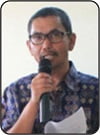The Folklore of Sanghiyang Prabu Borosngora as Phenomena of Panjalu History in Ciamis Regency, West Java, Indonesia
Abstract
ABSTRACT: Folklore is a historical phenomenon; and the science of folklore is a historical discipline. The science of folklore and the historical discipline are two integrated disciplines to produce inter-discipliner sciences. Panjalu is an area of the former kingdom of Islam in Priangan (the heartland of the Sundanese in West Java, Indonesia), whose people have folklore of Sanghiyang Prabu Borosngora. This folklore is an ancient cultural heritage of Panjalu’s people, whose existence is not only believed as imagination but also supported by the facts supporting people’s belief. This research was to study the phenomena of the history of Panjalu described in folklore of Sanghiyang Prabu Borosngora. This research was an ethnographic study applying descriptive analysis of which the data were taken from interviews and observation. The collected data were analyzed qualitatively. The result showed that the historicity of folklore of Sanghiyang Prabu Borosngora can be easily found in the appropriateness between intrinsic elements of literature (character, setting, and plot) and historical elements of which they can also be related to the existing historical inheritance. Beside that, the historicity of Sanghiyang Prabu Borosngora’s folklore is based on the spread of Islam in Priangan, whose truth is believed by Panjalu people. Hence, the folklore of Sanghiyang Prabu Borosngora can be used to reconstruct the history of Panjalu after being purified from pre-logical and irrational things.
KEY WORDS: History; Folklore; Phenomena; Panjalu People; Islamic Kingdom.

About the Author: Dr. Heri Jauhari is a Lecturer at the Department of Islamic Civilization, Faculty of Adab and Humanities UIN SGD (State Islamic University, Sunan Gunung Djati) Bandung, Jalan A.H. Nasution No.105 Cipadung, Bandung 40614, West Java, Indonesia. Corresponding author is: hari.jauhari@yahoo.com
How to cite this article? Jauhari, Heri. (2016). “The Folklore of Sanghiyang Prabu Borosngora as Phenomena of Panjalu History in Ciamis Regency, West Java, Indonesia” in TAWARIKH: International Journal for Historical Studies, Vol.8(1) October, pp.13-20. Bandung, Indonesia: Minda Masagi Press and UIN SGD Bandung, ISSN 2085-0980.
Chronicle of the article: Accepted (August 24, 2016); Revised (September 25, 2016); and Published (October 28, 2016).
Keywords
Full Text:
PDFReferences
Argadipraja, R. Duke. (1992). Babad Panjalu: Galur Raja-raja Tatar Sunda. Bandung: Mekar Rahayu.
Ayatrohaedi. (2005). Sundakala: Cuplikan Sejarah Sunda Berdasarkan Naskah-naskah “Panitia Wangsakerta” dari Cirebon. Jakarta: Pustaka Jaya.
Azra, Azyumardi. (2006). Islam in the Indonesian World: An Account of Institutional Formation. Bandung: Mizan Pustaka.
Brooner, Simon J. (2007). The Meaning of Folklore: The Analytical Essay of Alan Dundes. Utah: Utah State University.
Brunvand, Jan. (1978). The Study of American Folklore: An Introduction. New York: W.W. Norton, 2nd edition.
Burhanudin, Jajat & Kees van Dijk. (2006). Islam in Indonesia: Contrasting Images and Interpretations. Amsterdam: Amsterdam University Press.
Danandjaja, James. (2007). Folklor Indonesia. Jakarta: PT Pustaka Utama Grafiti.
Darlington, Yvonne & Dorothy Scott. (2002). Qualitative Research in Practice: Stories from the Field. London: Allen & Unwin.
Ekadjati, Edi S. (1977). Wawacan Sajarah Galuh. Bandung: Penerbit EFEO.
Ekadjati, Edi S. (2005). Polemik Naskah Pangeran Wangsakerta. Jakarta: Pustaka Jaya.
Goertz, Gary & James Mahoney. (2012). A Tale of Two Cultures: Qualitative and Quantitative Research in the Social Sciences. Princeton: Princeton University Press.
Hidayat, Yayat. (2010). “Mengenal Warisan Kerajaan Panjalu” in Majalah Misteri, Edisi 20 Pebruari — 04 Maret.
Interview with H. Saleh Sasmita, a cemetery caretaker of Bumi Alit Panjalu, in Ciamis, Indonesia, on January 27, 2013.
Iskandar, Yoseph. (1997). Sejarah Jawa Barat: Yuganing Rajakawasa. Bandung: Geger Sunten.
Jauhari, Heri. (2015). Cerita Rakyat Panjalu: Kajian Fungsi, Makna, dan Falsapah. Bandung: UNPAD [Universitas Padjadjaran] Press.
Munoz, Paul Michel. (2006). Early Kingdoms of Indonesian Archipelago and the Malay Peninsula. Singapore: Editions Didier Millet Ltd.
Propp, Vladimir. (1997). Theory and History of Folklore. Minneapolis: University of Minnesota Press.
Putra, Heddy Shri Ahimsa. (2001). Strukturalisme Levi-Staruss, Mitos, dan Karya Sastra. Yogyakarta: Galang Press.
Ratna, Nyoman Kutha. (2004). Teori, Metode, dan Teknik Penelitian Sastra. Yogyakarta: Pustaka Pelajar.
Ratna, Nyoman Kutha. (2008). Teori, Metode, dan Teknik Penelitian Sastra. Yogyakarta: Pustaka Pelajar.
Rusyana, Yus & Ami Raksanagara. (1978). Sastra Lisan Sunda: Cerita Karuhun, Kajajaden, dan Dedemit. Jakarta: Depdikbud RI [Departemen Pendidikan dan Kebudayaan Republik Indonesia].
Sastrowardoyo, S., S.D. Damono & A.K. Achmad [eds]. (1985). Anthology of ASEAN Literatures: Oral Literature of Indonesia. Jakarta: The ASEAN Committee on Culture and Information.
Spradley, James P. (2006). Metode Etnografi. Yogyakarta: Tiara Wacana, Terjemahan.
Suganda, Her. (2008). “Naskah Sunda Kuno: Antara Sejarah dan Nilai Sakral” in newspaper of Kompas. Jakarta, Indonesia: 24 Mei.
Sukardja, H. Djadja. (2002). “Situs Karangkamulyan, Ciamis” in newspaper of Pikiran Rakyat. Bandung: 10 Juli.
Sumardjo, Jakob. (1994). Simbol-simbol Artefak BudayaSunda. Bandung: Penerbit Kelir.
Sumaryadi, Sugeng. (2004). “Sejarah Panjang yang Terus Dikenang” in newspaper of Media Indonesia. Jakarta: 13 Maret.
TPSG [Tim Peneliti Sejarah Galuh]. (1972). Galuh Ciamis dan Tinjauan Sejarah. Ciamis: Pemdakab [Pemerintah Daerah Kabupaten] Ciamis.
